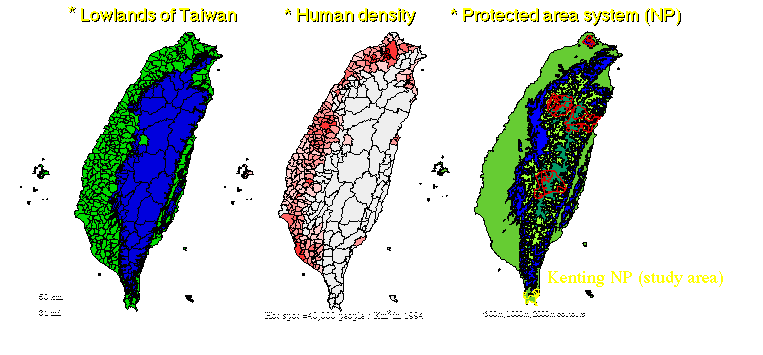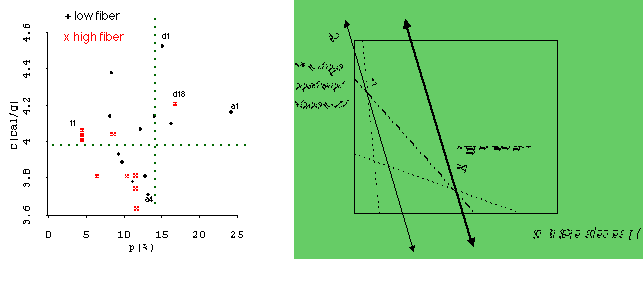
Presentation Outlines
Assess Potential Habitat of
Extirpated Formosan Sika Deer in Taiwan

Sika Deer
One of Cervus species of deer in Asia
13 subspecies: Japan, Korea, China, Taiwan, and Vietnam
Introduced to Europe, Australia, New Zealand and United States
Formosan Sika Deer
Endemic subspecies in Taiwan
Native Habitat : below 300 meters, originally widely distributedin the whole lowlands
of Taiwan
Favorable market values
Cultural Symbol and Economic Value
In Chinese diet culture & traditional medicine
considered as magic animal because: 1. partially developed antlers
2. other useful products: bone marrow, meat, penis, tendon, fat, blood, teeth, bile
& skin
Wide array of deer parts makes deer economically valuable
So many places named by deer, but where is the deer? Extirpation by 1970
In 19th: Over-harvest for Deerskins
Native tribesmen and immigrants hunted deer for food, by-products, & goods of
international trade
e.g. in the late 19th: Sika deerskin exports peaked at 100,000 per year.
In 20th: Habitat Change & Fragmentation, Especially After World War II
Native habitat was destroyed by expanding agriculture and economic development.
Extirpation by 1970
Severe exploitation and habitat degradation led to the sika deer's extirpation.
Survival deer were left in captivity (zoo and private garden) for exhibition and
economic use.

Formosan Sika Deer Recovery Project since 1982
1974: IUCN listed as most threatened deer worldwide.
1982: Taiwan appointed the Sika Deer Specialist Group of Recovery Plan.
1984: Removed core population from Taipei city zoo to Sheting, Kenting NP, Taiwan.
1991: Reintroduced in fenced closure
1995: Released in adjacent field (in the wild)
1999: Estimated updated population - 300 deer in closure & 150+ deer outside
by late 1999
Q: Without any detailed ecological knowledge before Sika deer's extirpation, how do we know the recovery status in field?
Q: What is the future of recovery Sika deer? How to apply our limited knowledge to conservation?
Goal: Assess the potential habitat of recovery Sika deer
Result of the first decade of deer recovery
1. Food selection
1a. Diet diversity
1b. Nutritional optimization
2. Habitat selection
2a. Rest site selection
2b. Forage patch selection
What is the future of Formosan Sika Deer?
3. Evaluate the Potential Habitat for the Future Recovery Deer
3a. Potential habitat estimation: beyond carrying capacity
3b. Social perspectives: deer-human conflicts
Conclusion
Study Area - Sheting Reintroduction Park In Kenting National Park
Dry season (summer): 90% rainfall concentrated, male grows antlers, female give birth of calf
Wet season (winter): windy environment in Kenting, male ruts and traces female, female in pregency


Radio-collared deer: 2 males & 3 females from March 1993 to August 1994
What is the situation now for deer recovery?
Field observation with telemetry (response variables)
Rest site (yellow): location, duration
Foraging bout: patch location (green), intake time, food plant selection, behavior

Male deer in wet season
Environmental survey (predictor variables)
Geomorphic factors Vegetation
elevation - Distribution
distance to river / rock / trail - Abundance

Simpel biomass index : measure canopy / layer height for groups: (A) Tree (D) Shrub (C) Vine (E) Herb & (F) Grass
Result
Food Supply Approach : There are two kinds of optimizations
1. Diet Composition
60% is 15 food plant species (diverse food plants form native plant communities)
35% is legume a1 (intake amount ~ food plant distribution, abundance, nutrition?)
2. Nutritional optimization
Examine nutritive contents for dry matter (%), acid detergent fiber (ADF %), protein
(%), and energy (cal/g)
Which nutrients are most important for deer intake?
Regression Model (using only protein and energy):
log (forage rate) = -1 + 0.3 log (protein) + 2 log (energy) (R^2=0.77, F=33.4, p<0.0001)

Why Sika deer feed the exotic legume a1 (Leucaena glauca ) so much (35%!)?
Plant a1 is an exotic legume from South America
invaded lowlands of Taiwan after WWII: from pulp material plant to ecological invasion
most favorable food (35% diet): provide rich protein (p) and energy (c) = optimal
choice in nutrition
Deer adapted to this widespread and exotic plant (a1) well
Deer balanced the nutritive requirements since their release in 1991

Plant a1 is an exotic legume
Verbena d18: overabundant as a1, but toxic because of 2nd compounds
Citrus d1: less er abundant
Mulberry a4: favorable food plant, deer impacted regeneration, fallen leaves is the
important food reserve in dry winter
Grass f1~3: fiber is also needed by rumminates
Suitable Vegetation Communities: those favorable plants in Sheting also occur in other potential areas
7 vegetation types in lowlands of Taiwan (Potential Habitat)
Natural plant communities (3 types) - historic range could provide diverse diets
for Sika Deer
Zone I: Semi-deciduous mixed forest in lowlands (f1 a4)
Zone II: Tropical evergreen & broadleaf forest - Ficus-Machilus Type (a4 d38)
Zone III: Acacia confusa (a33) plantation & lowland secondary forest
Artificial plant communities (4 types) - partially converted to human-dominated
ecosystem
farmland & suburban area: rice, tea, sugarcane, fishpond
 Flora of Taiwan, 1994
Flora of Taiwan, 1994
Since we predict the possible area for suitable food plant communities,
 What is the deer's unique habitat
selection requirement?
What is the deer's unique habitat
selection requirement?
Table. Diagnostic regression indicates the key variables for seasonal rest site selection. Response (y) is the distance to rest sites, which is a continuous variable and dependent on plants and geomorphic factors.

Table. Key plants for rest site selection

Null Hypothesis: some factors are not significantly important (eta is zero)
Alternative Hypothesis: some factors are important to keep in regression model (eta is not zero)
Focusing on geomorphic factors with binomial logistic
regression
Binary response variable (y)
- rest site = 1
- forage patch = 0
continuous predictor (x) : geomorphic variable
blue line :
an estimate of mean function E(y|x) from empirical data
lowess smoother (0.6) is a locally weighted scatterplot smoother
y|x has a Bernoulli distribution with a probability of site “success” (site=1)
E(site | elevation) = Prob(site=1 | elevation)
the probability to be a rest site given a specific elevation
a function of elevation
red line :
logistic regression model fit
our mission is to fit the model to match the data curve



Foraging Patch Selection
(left) male deer in wet summer (right) male deer in dry winter

(left) female deer in wet summer (right) female deer in dry winter
Human Use of Resource and Human-Deer Conflicts
Public Relationship and Natural Resource Community
Ecosystem management should integrate ecological knowledge within a socio-political
framework.
What’s the problem?
Interviews (1996): part of local residents disagreed with the land use regulations
by national park, because
1. At the beginning, the whole project was mostly targeted as a single endangered
species plan.
2. Ignored the socio-economically acceptability and the social changes in rural communities
during the eco-restoration process.
3. Residents didn't realize the benefits from this recovery project.
4. Human-park or human-deer conflicts resulted from the low degree of public-involvement
in the decision-making process.
How to Improve Recovery Project From a Single-Species Project toward A Human-Dominated Ecosystem Management?
Sika Deer is considered:
A working goal and a live symbol as an umbrella species.
Ecosystem management: a symbol to rebuild the lost components.
To maintain a self-sustainable deer population, Taiwanese people have to make a public
decision to restore the environment.
Symbolizes the contemporary conservation effort in Taiwan
The whole biodiversity and environment are highly endangered today.
Potential habitat of Sika Deer is at severe risk.
Seek a win-win situation
Conflicting utilities of human economic development cause strong habitat loss and
fragmentation.
Decision: put tax money into ecosystem conservation with economic efficiency.
Sustainable development
 Future
Future
The eco-recovery of Sika Deer in a human-dominated ecosystem is:
- Starting point to concern the well being of both human and land.
- Rebuild a relationship between development and over-development
- Adjust the mixed cultural-or-natural land use
- Biodiversity and cultural activities have co-existed for a long time.
- Need an integrated eco-recovery plan to cover the entire landscape of Taiwan.
- Include economic, ecological, recreational, cultural and aesthetic values.
“ The ways to recovery are long and complex, which are reminders that wildlife and civilization can be compatible."
There is now still time.
(full text of potential habitat)
(full text of nutrition optimization)